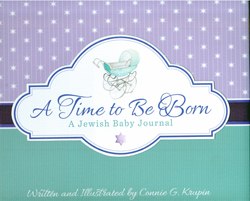Connie G. Krupin, A Time To Be Born: A Jewish Baby Journal, Arbador Publications LLC, (c ) 2012, 119 pages, ISBN 978-0-615-57127-0, $50.
By Donald H. Harrison
 SAN DIEGO — From the inside covers with a family tree on which may be filled forbearers’ English and Hebrew names to the Hebrew glossary at the end of the book, this baby’s album has a Jewish tam pleasing for those whose lives already are frum and educational for those who desire to strengthen their Jewish understanding.
SAN DIEGO — From the inside covers with a family tree on which may be filled forbearers’ English and Hebrew names to the Hebrew glossary at the end of the book, this baby’s album has a Jewish tam pleasing for those whose lives already are frum and educational for those who desire to strengthen their Jewish understanding.
Krupin’s Talmud- and Bible-citing, Proverb quoting book featuring her own warm and loving illustrations goes far beyond a primer in Judaism. It is formatted to encourage parents in painstaking fashion to set down a remarkably complete account of their infants’ first five years — a record book that if adhered to will provide the child’s future biographer–{after all, he or she is bound to grow up to be the President, right?}–with a mother lode of information.
There are features in this album, lavishly designed by Rikki Campbell Ogden, that, in combination, make A Time to Be Born a unique memento of a Jewish child’s life.
The book starts with pre-natal experiences, asking parents to recall in writing what their first comments were after verifying that mommy indeed was pregnant.
It provides places for a labor diary, a record of baby’s birth time, weight, length and date on both the Hebrew and common calendars, along with such statistics as baby’s blood type, Apgar score ((Appearance, Pulse, Grimace, Activity, Respiration), eye and hair color, head circumference and that most difficult of all questions, “baby most resembles?”
On a page for the child’s birthdate, parents may fill in the headlines of the day, the name of the sitting President of the United States, the cost of a gallon of milk and of an average home, some of the top pop songs, and the cost per hour of babysitting.
It also ask the names of the child’s siblings and the birthdates, and then invites some reflections by the mother on such topics as the values she believes are most important, what the best thing about being a mother is, and what is her favorite memory of her own mother. Daddy gets to fill out a similar questionnaire.
Forty pages have already gone by (half of them filled with the author/ illustrator’s baby-inspired art work by the time one gets to the brit milah (for boys) or the simchat bat (for girls). There’s a page — in case the child is a first son — for the Pidyon Ha Ben ceremony, a chart for baby’s heights and weights at various monthly and yearly anniversaries, a record sheet for immunizations (with a recipe on the facing page for chicken soup!) and places to note various ‘firsts’ in baby’s life — including the first time baby raised his or her head, or rolled from back to tummy, or laughed, or sat without support.
The parents also are invited to observe the child’s social development. How does baby play with other children? What is his or her reaction to pets?
The diligent parent will note variations and characteristics in the child’s behavior at playtime and bedtime. They will record baby’s first haircut (saving a lock of hair) and note baby’s first experiences with all the major Jewish holidays.
One question, not likely to be found in many other baby books, asks about the baby’s reaction to first hearing the sound of the shofar on Rosh Hashanah.
Krupin is to be congratulated for developing such a comprehensive an d eye-arresting album for doting and kvelling Jewish parents. This is an album which, on behalf of future journalists and historians everywhere, I urge all parents to fill out as completely as possible.
*
Harrison is editor of San Diego Jewish World. He may be contacted at donald.harrison@sdjewishworld.com